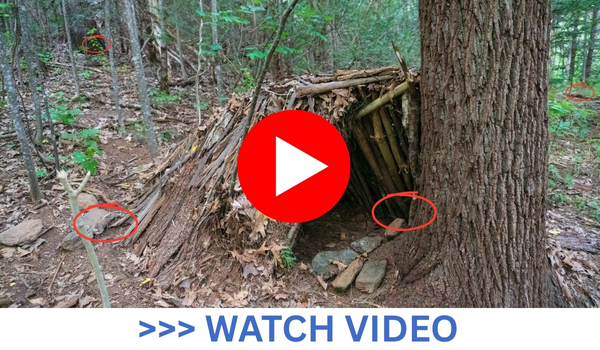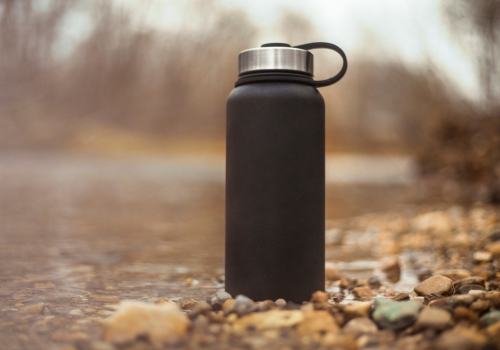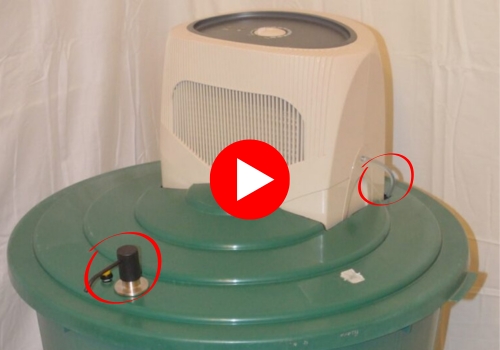I Lived in The Woods for 15 Days and This is What Almost Killed Me

I’ve spent a lot of time outdoors. I spent 15 years in the Army, which involved plenty of aggressive camping in all sorts of environments. I’ve also done a lot of hiking. I’m no stranger to nights in the woods. Recently, though, I decided to do something a little different: a survival in the woods challenge.
Most of the times I’d camped out before, it was because I was already outdoors for another reason. This time I decided I’d just spend two weeks in the woods, and see how I got on. I didn’t have anything else to do, whether it was a military mission or climbing a mountain. All I had to do was survive and stay as comfortable as possible.
The challenge of living in a small forest clearing for 15 days gave a lot of practical skills a good workout – I can now keep a fire going with about half as much wood as I’d have needed previously.
More than that, though, it also taught some valuable lessons about the reality of living outdoors. Most of this is stuff we all know at some basic level, but maybe don’t fully understand until we’ve lived it. Here are the top things I took from the experience.
Shelter: More Important Than I Thought
When people think about survival, most imagine food and water first. But let me tell you—after just one night of cold, wet wind cutting through my tarp, I realized that good shelter is what really keeps you alive.
I went in with a basic setup: a tarp, some cordage, and a few stakes. Nothing fancy. I’d built dozens of shelters in the Army, so I figured I’d knock it out in ten minutes and move on. Big mistake. I spent the first two nights repositioning, adjusting, and learning the hard way what works and what doesn’t.
The biggest lesson? Location matters. That cozy-looking low spot might feel sheltered from the wind, but when the rain starts, it turns into a puddle. I ended up shifting my camp a few feet uphill and re-anchoring everything more securely.
A lean-to with a decent windbreak, placed just right, made all the difference. I also rigged a small heat reflector from logs and rocks, which helped bounce warmth from the fire back into my shelter.
You can survive without food for weeks, but one cold, wet night without decent shelter can end the whole game. Learn from The Wilderness Long-Term Survival Guide all about building a strong shelter, from a real survival expert: Nicole Apelian.

Firewood Is A Challenge
One of the first things I did when I set up my campsite was to collect all the dry, dead wood that was lying around. Any deciduous forest will have dead branches lying around, and if they haven’t been lying directly on damp ground they’re usually dry and perfect for fuel. It didn’t take long to build an impressive pile of sticks and branches.
The problem is that as impressive as that pile looked, as soon as I actually started feeding a fire it dwindled with alarming speed. After just a few days I was having to search further and further afield for more wood.
Picking up fallen branches is only a viable source of wood for a few days. In the long term you’re going to have to start cutting timber and letting it season. It’s also worth doing anything possible to save fuel. A big roaring fire might be comforting at night, but it’s also a luxury you can’t afford.
A smaller fire with a reflector built behind it will keep you just as warm, at less cost in firewood. A wood-burning rocket stove, or even a hobo stove made from a can, will let you cook efficiently while burning far less wood than an open fire.
So Is Water
When I meet other hikers they’re often surprised by how much water I carry. It seems most people carry around two liters of water with them. I have more than double that – a three-liter hydration system and two one-liter bottles. Yes, it’s heavy, but I learned in the Army that you really don’t want to run out of it.
Living in the woods quickly taught me that even five liters isn’t enough. Technically it’s enough for more than a day, but I seemed to be heading for the stream at least once, and usually twice, a day to refill all my containers.

That ate up a lot of time I could have spent doing other things. If you’re going to be camping somewhere for more than a couple of days you need some kind of larger container, so you can spend less time hauling water. Even a five-gallon jerrycan would work. It’s big enough to last you at least two or three days, but can still be carried a fair distance.
A Brush with Dehydration Nearly Ended It All
Even with more water than most hikers carry, I came dangerously close to a life-threatening mistake. On Day 9, while hauling firewood under a hot, humid sun, I underestimated how much I was sweating. I was pushing hard, thinking I could stretch my nearly empty water bottles a few more hours before refilling at the stream. That was a critical error.
By late afternoon, the signs hit hard: light-headedness, a mouth like sandpaper, and foggy thinking. When I bent down to adjust my boot and nearly blacked out standing up, I knew I was in serious trouble. Dehydration was creeping in fast, and I’d ignored the warning signs.
>> How to Recognize a Heart Attack and What to Do Next
The stream was only a ten-minute walk, but it felt like a marathon. My legs wobbled, and I had to lean on trees just to stay upright. When I finally reached the water, I was so desperate I drank straight from the stream—unpurified, against every rule I’d set for myself. In that moment, survival trumped protocol.
It took hours to recover, lying in my sleeping bag, replaying how close I’d come to disaster. Five empty water containers sat in my pack, mocking my poor planning. The lesson was brutal but clear: always monitor your hydration, pace yourself, and never let your water supply run low. No amount of gear matters if you don’t respect your body’s limits.
A Lesson for Bugging In Too
Fifteen days in the wild taught me a brutal lesson: it wasn’t the lack of a solid shelter, scarce food, or even nearby predators that came close to ending me. It was the lack of water. Let that sink in. Whether you’re deep in the backcountry or facing a crisis at home, running out of water can kill you just as fast.
As a prepper, you know the unexpected is an enemy most people ignore. To avoid being caught off guard, you need to prioritize water like your life depends on it, because it does. Stockpile a generous supply, calculated smartly for you and your family. Rotate it regularly to keep it fresh.
Don’t skimp on this. Better yet, secure your water from reliable sources—ideally not the public grid. When SHTF, you want to be ready, not scrambling.
Now imagine having access to up to 50 gallons of clean water every single day—without relying on the grid. Sounds impressive, right? There’s a compact, backpack-sized device that makes this possible, even in extreme desert environments. It’s currently used by military units worldwide, and the best part? It pulls moisture straight from the air—no external power source or water supply needed.

For anyone serious about long-term water security, you might also want to check out something called The Water Freedom System. It’s been adopted by armed forces in countries like the U.S., UK, Israel, and India. It could be a game-changer for your preparedness plans. Take a closer look here.
Now let’s move on to my next conclusion after spending more than two weeks in the woods.
>> The Water You Need in a Crisis and How to Preserve It
Everything Takes Time
Part of the appeal of living in the woods is the simplicity – but that comes at a price. Modern life does have a lot of clutter, but it’s also easy in many ways. How many times have you made dinner by just putting something in the oven and taking it out when the timer pings? You can do other things while it’s cooking.
It isn’t like that in the woods. When you cook over a fire you need to check it regularly. You can never wander too far away in case the fire flares up or dies down while you’re gone. Often, you just can’t leave the fire at all. If dinner takes half an hour to cook that’s half an hour you can’t spend doing anything else.
Most tasks turn out to be time-consuming. I was spending 20 minutes a day collecting and purifying water. By the end I was spending two hours a day or more collecting firewood. Washing clothes in the stream took time. Everything took time. You need to be realistic about how much you can accomplish in a day.
Foraging: Not as Easy as It Sounds
I didn’t go into the woods expecting to live off the land entirely—but I wanted to supplement my rations and test my foraging skills. Let me tell you, finding food in the wild is humbling.
Yes, I found some wild edibles—berries, dandelion greens, plantain, a few nuts. But calories were hard to come by, and the effort-to-reward ratio was brutal. Some days I spent over an hour looking and came back with maybe 200 calories’ worth of food. That’s not sustainable.
 And unless you really know your plants, it’s risky. There were mushrooms I recognized from guidebooks, but I didn’t touch them. One mistake and you’re poisoned, alone, miles from help.
And unless you really know your plants, it’s risky. There were mushrooms I recognized from guidebooks, but I didn’t touch them. One mistake and you’re poisoned, alone, miles from help.
What worked best was foraging as a supplement, not a primary food source. The greens helped balance my diet and stave off fatigue. I also set a few basic traps, but caught nothing. That’s another skill I’ll need to revisit.
Foraging can work—but only if you’ve trained beforehand and your energy levels are still high enough to hike, search, and process. Waiting until you’re starving is too late.
Start learning your local wild edibles now. Get out there, practice ID’ing and prepping them before the SHTF. A pocket field guide is worth more than gold in a crisis. My top pick? The Forager’s Guide to Wild Foods. It’s packed with critical intel like:
- The Plant That Can Save Your Life in a Crisis
- What to Do ASAP When You Spot an Alligator Tree
- How to Find the Superweed Known as “Wild Spinach”
…plus a ton more know-how to keep you fed straight from nature’s bounty.
Love The Light
As well as the amount of time everything takes, your days effectively begin at dawn and end at sunset. It’s hard to understand what a difference electric lighting makes to your life until you have to do without it. When the sun goes down in the woods, most activities stop.
If you can’t do it in the illumination from a flashlight or lantern, you’re not doing it until the morning. I quickly learned to prioritize the things that needed to be done in daylight and the ones that could wait. Foraging for firewood was a daytime task, for example, but cutting and stacking it could be done by firelight.
Attention To Detail Matters When it Comes to Survival in The Woods
In the woods you can’t let things slide. At home, it doesn’t matter much if you want to put off doing the dishes until the morning. Your kitchen will look untidy, but there’s no harm done. Outdoors it’s a different story. Leave the dishes until morning and the chances are you’ll get woken up during the night as something comes to investigate them.
You need to wash up right away or you’ll quickly attract insects – or, worse, larger animals – to your camp. Depending on what your local wildlife is like the consequences of this range from annoying to extremely dangerous.
Every task is the same; you can’t afford to delay cleaning, repairing or even packing things away. In the woods, loose gear has an amazing ability to vanish. When you take something out of your rucksack, put it away again as soon as you’ve finished using it.
Final Thoughts
Looking back at everything I learned, one thing is crystal clear: there’s no such thing as a lazy day in the woods. Just staying warm, dry, fed, and hydrated demands most of your daylight hours—and daylight itself runs short, especially outside of midsummer.
Survival, after all, is about discipline, planning, and adapting to whatever the environment throws at you—day after day, without backup.
So when you’re planning for long-term survival—whether bugging out or bugging in—factor in the grind. Not just the gear, but the daily grind of hauling water, chopping wood, cooking from scratch, staying warm, and staying alert.
I found Dr. Nicole Apelian’s survival advice in the wild truly inspirational. I also highly recommend The Forgotten Home Apothecary, where you can learn no less than 250 natural remedies for the most common health issues!
You may also like:

Better Than Bugging Out
How to Make the Ultimate Fire Starter That Burns Like Hell (Video)
Overrated “Survival Skills” You Don’t Actually Need
11 Fatal Mistakes To Avoid When Bugging Out
Read the full article here









